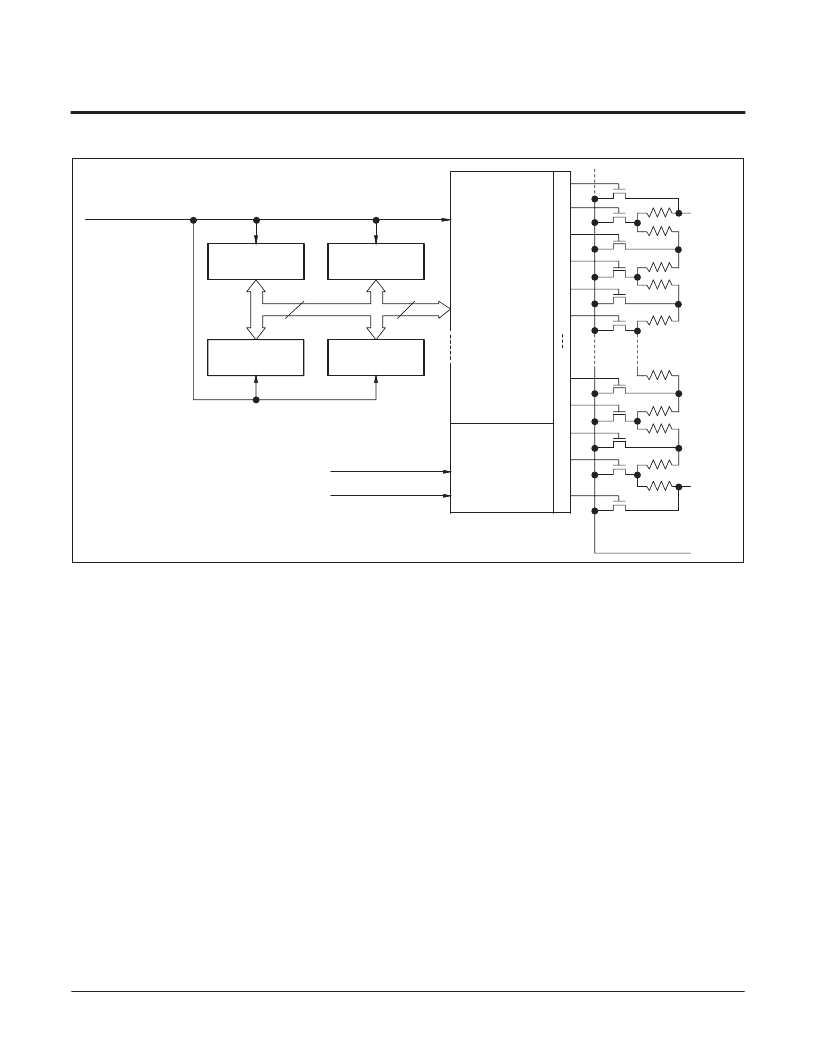- 您現(xiàn)在的位置:買賣IC網(wǎng) > PDF目錄371282 > X9258 Quad Digital Controlled Potentiometers (XDCP) PDF資料下載
參數(shù)資料
| 型號: | X9258 |
| 元件分類: | 數(shù)字電位計 |
| 英文描述: | Quad Digital Controlled Potentiometers (XDCP) |
| 中文描述: | 四數(shù)字(數(shù)字電位器控制電位器) |
| 文件頁數(shù): | 8/22頁 |
| 文件大?。?/td> | 413K |
| 代理商: | X9258 |

X9258
Characteristics subject to change without notice.
8 of 22
REV 1.1.7 2/4/03
www.xicor.com
Figure 8. Detailed Potentiometer Block Diagram Detailed Operation
Serial Data Path
From Interface
Circuitry
Register 0
Register 1
Register 2
Register 3
Serial
BUS
Input
Parallel
BUS
Input
Wiper
Counter
Register
(WCR)
INC/DEC
Logic
UP/DN
CLK
Modified SCL
UP/DN
V
H
/R
H
V
L
/R
L
V
W
/R
W
If WCR = 00[H] then V
W
/R
W
= V
L
/R
L
If WCR = FF[H] then V
W
/R
W
= V
H
/R
H
8
8
C
o
u
n
t
e
r
D
e
c
o
d
e
All DCP potentiometers share the serial interface and
share a common architecture. Each potentiometer has
a Wiper Counter Register and four Data Registers. A
detailed discussion of the register organization and
array operation follows.
Wiper Counter Register
The X9258 contains four Wiper Counter Registers,
one for each DCP potentiometer. The Wiper Counter
Register can be envisioned as a 8-bit parallel and
serial load counter with its outputs decoded to select
one of 256 switches along its resistor array. The
contents of the WCR can be altered in four ways: it
may be written directly by the host via the Write Wiper
Counter Register instruction (serial load); it may be
written indirectly by transferring the contents of one of
four associated Data Registers via the XFR Data
Register instruction (parallel load); it can be modified
one step at a time by the Increment/Decrement
instruction. Finally, it is loaded with the contents of its
data register zero (R0) upon power-up.
The WCR is a volatile register; that is, its contents are
lost when the X9258 is powered-down. Although the
register is automatically loaded with the value in R0
upon power-up, it should be noted this may be
different from the value present at power-down.
Data Registers
Each potentiometer has four nonvolatile Data
Registers. These can be read or written directly by the
host and data can be transferred between any of the
four Data Registers and the WCR. It should be noted
all operations changing data in one of these registers
is a nonvolatile operation and will take a maximum of
10ms.
If the application does not require storage of multiple
settings for the potentiometer, these registers can be
used as regular memory locations that could possibly
store system parameters or user preference data.
相關(guān)PDF資料 |
PDF描述 |
|---|---|
| X9258TZ24-2.7 | DIGITAL POTENTIOMETER|CMOS|BGA|24PIN|PLASTIC |
| X9258TZ24I | DIGITAL POTENTIOMETER|CMOS|BGA|24PIN|PLASTIC |
| X9258TZ24I-2.7 | DIGITAL POTENTIOMETER|CMOS|BGA|24PIN|PLASTIC |
| X9258UZ24 | DIGITAL POTENTIOMETER|CMOS|BGA|24PIN|PLASTIC |
| X9258UZ24-2.7 | DIGITAL POTENTIOMETER|CMOS|BGA|24PIN|PLASTIC |
相關(guān)代理商/技術(shù)參數(shù) |
參數(shù)描述 |
|---|---|
| X9258)06 | 制造商:INTERSIL 制造商全稱:Intersil Corporation 功能描述:Quad Digital Controlled Potentiometers |
| X9258_11 | 制造商:INTERSIL 制造商全稱:Intersil Corporation 功能描述:Quad Digital Controlled Potentiometers(XDCP?) |
| X9258_13 | 制造商:INTERSIL 制造商全稱:Intersil Corporation 功能描述:Low Noise/Low Power/2-Wire Bus/256 Taps |
| X9258TB24 | 制造商:XICOR 制造商全稱:Xicor Inc. 功能描述:Quad Digital Controlled Potentiometers (XDCP) |
| X9258TB24-2.7 | 制造商:XICOR 制造商全稱:Xicor Inc. 功能描述:Quad Digital Controlled Potentiometers (XDCP) |
發(fā)布緊急采購,3分鐘左右您將得到回復(fù)。